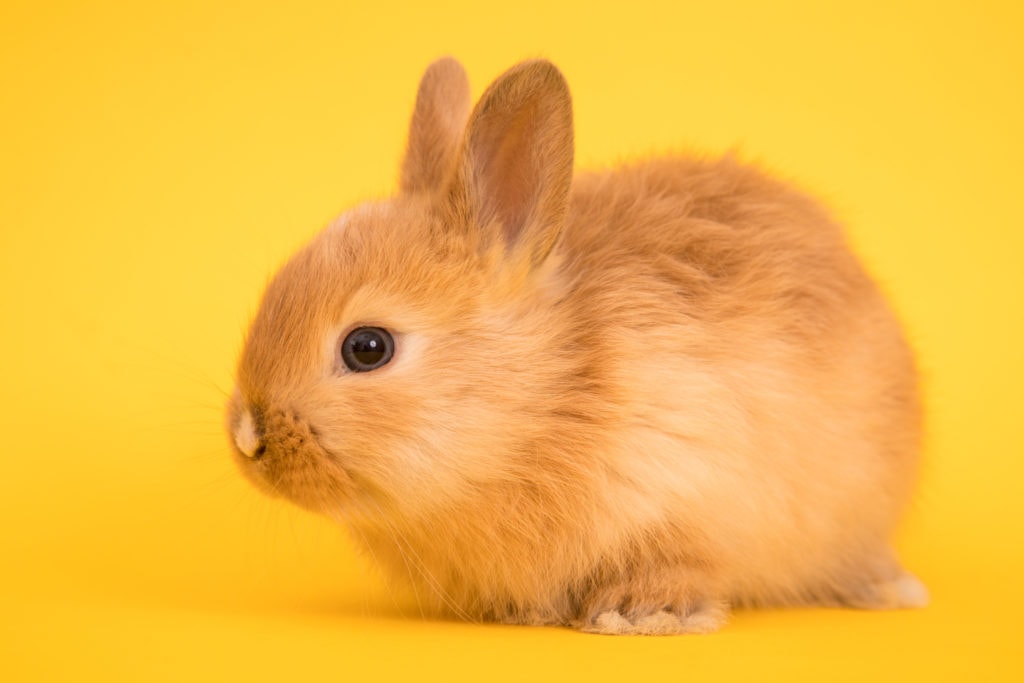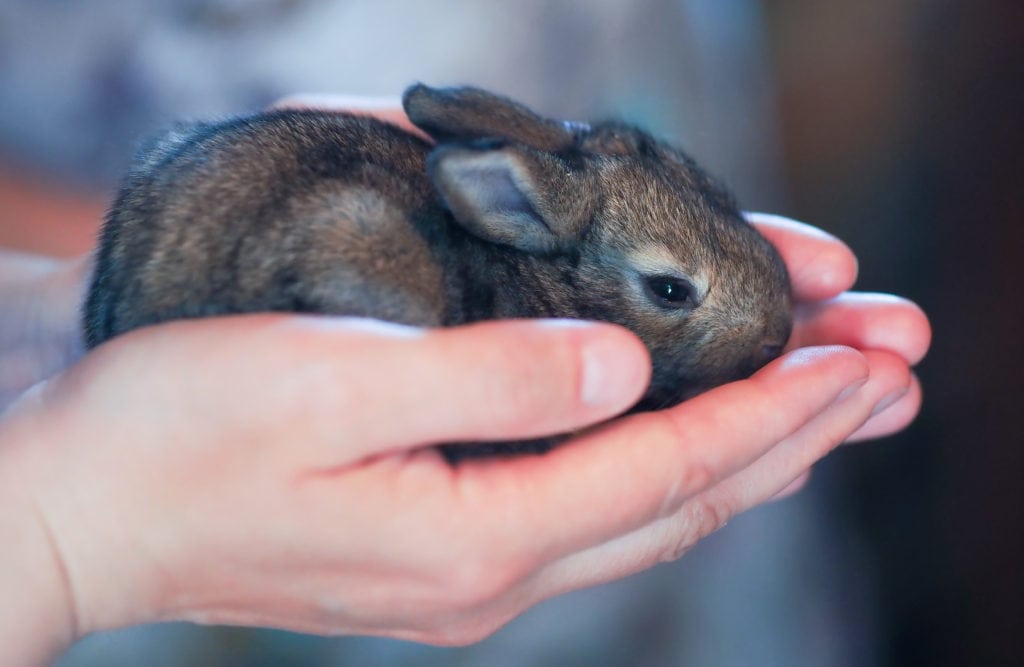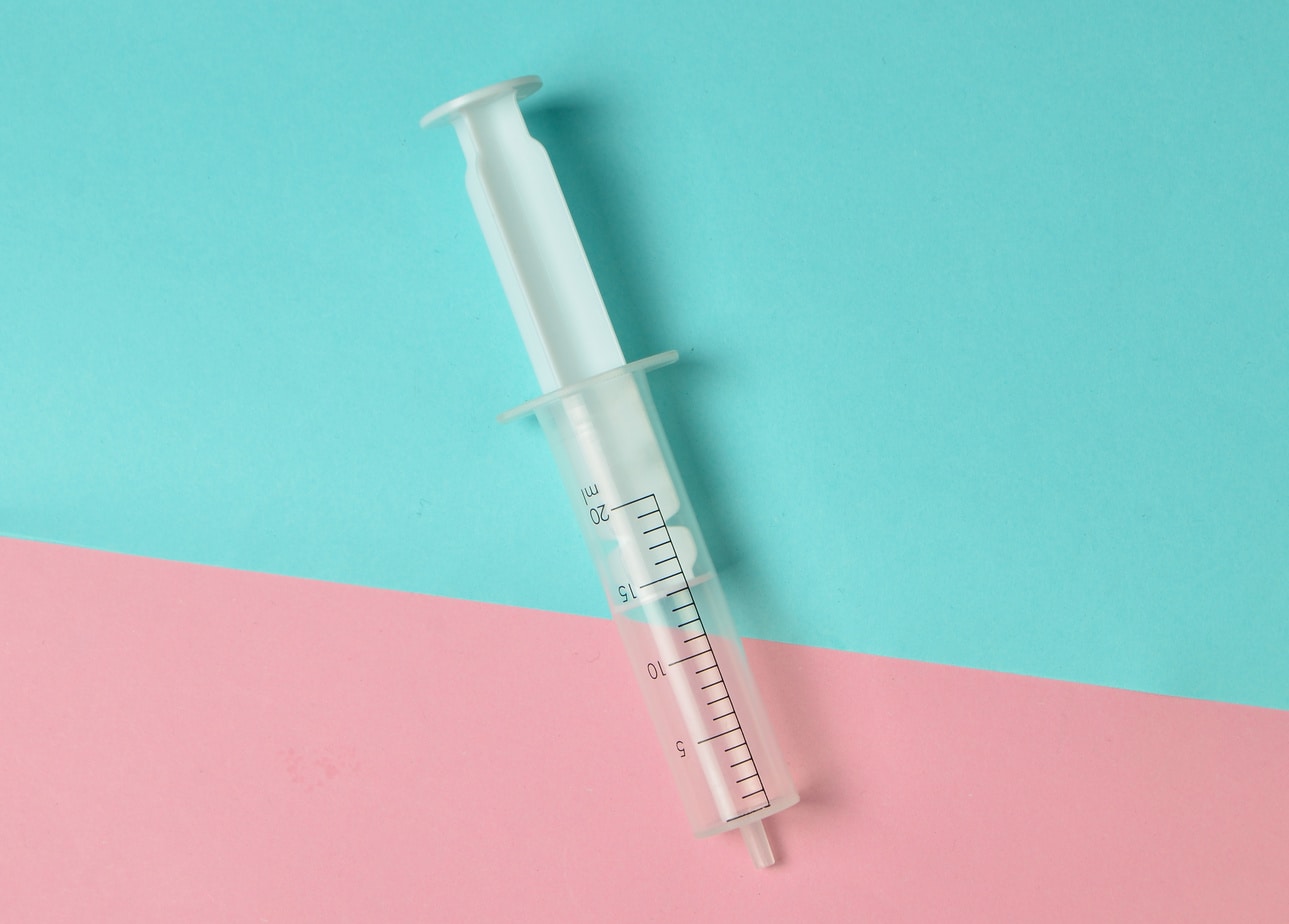
Feeding newborn domesticated rabbits on your own may be a daunting task. Fortunately, you can find success if you’re careful, attentive, and knowledgeable about their needs.
Baby rabbits can be fed kitten milk replacer or goat’s milk through a sterile oral syringe. Feed them twice a day until they are at least eight weeks old. The amount of formula they require depends on their age, but they can eventually be weaned after eight or nine weeks.
Here are some more detailed instructions and suggestions for feeding baby bunnies.
What to Feed
The best options for feeding baby rabbits are kitten milk replacer (KMR) or goat’s milk. KMR is commonly found in pet stores or your local veterinarian’s clinic. Goat’s milk may or may not be available in nearby stores, so KMR is often the go-to formula for baby rabbits. Simply follow the formula’s instructions to create the kit’s milk replacement.
Do not feed baby rabbits regular cow’s milk. It is toxic to them.
It may also be a good idea to add at least a tablespoon of 100% sugar-free heavy whipping cream to the formula during feedings. Rabbit milk is high in calories, so supplementing the formula with heavy whipping cream can help the babies grow.
If there is another healthy adult rabbit in your household, you can collect their cecotropes, the clumped, soft droppings rabbits usually eat, and mix a pellet with the formula. This will serve as a supplement for the normal bacteria baby rabbits will need in their intestinal tracts to promote a healthy digestive system.
You’ll only need one cecotrope per day for four to five days to mix with the replacer, and it’s especially important to supplement newborns that are less than a week old.
As soon as the baby rabbits’ eyes are open (about seven to ten days old), you can introduce them to food such as pellets and hay, such as oat hay or timothy hay. Even if they don’t eat it at the beginning, the presence of the food will allow them to grow accustomed to it. They will eventually munch on the pellets or hay, but be sure to still provide them with formula.
Rabbits three to four weeks old can be introduced to water. You may place a shallow bowl of water in their enclosure or allow them to use the water bottle in their mother’s pen.
At eight to twelve weeks old, you may begin to feed them vegetables and fruit. But because you need to be cautious in your approach to introducing new foods to young rabbits, use the veggies and fruits sparingly.
And remember, if you have a mother rabbit who has recently given birth to babies and you haven’t seen her feed them, this shouldn’t be a cause for panic. Mother rabbits often nurse their kits at night when it is quiet. Only intervene with additional feedings if you’re certain that the babies aren’t getting fed enough, which they may show in their:
- Lethargy
- Lack of growth
- Cold and/or blue skin
- The tendency to cry for prolonged times during feeding
- Shriveled skin due to dehydration
If you suspect that’s the case, see the resource on this site titled Guide: What to Do If Your Rabbit Isn’t Feeding Her Babies to learn some simple ways you can help.
When to Feed

Because baby rabbits are so small, they can easily die from overfeeding. You should feed orphaned rabbits twice a day at max with plenty of time between feedings.
If you’re supplementing a baby rabbit who isn’t getting enough milk from his mother, determine when would be the best time to feed him according to the small to none nourishment he may receive. This means you may only feed him once a day or every few days, especially if he can work his way back to nursing better from his mother.
After you feed, it is important for newborns whose eyes are not yet opened to have their intestinal and urinary tracts stimulated. Normally, they would have their mothers lick their bums, which would encourage defecating and urinating and make for a quick cleanup. But if you’re feeding them instead because they’ve been orphaned, you will need to do this for them.
Use a warm, damp cotton ball and gently stroke the bunny’s anal area. Even when he may start to go to the bathroom, don’t stop stimulating until the baby is done. Once his eyes are opened, you will not have to do this anymore, and he can go to the bathroom on his own.
As baby rabbits get a few weeks older, their feeding times may be reduced to once per day if they seem to be healthily growing and have round bellies to signify that they’re being well-fed. This will also encourage the weaning process.
How Much to Feed
The amount of nourishment baby bunnies need varies, depending on their age and natural breed size. But since they are very small when they are young, they only need a tiny bit of milk during the twice-daily feedings. The suggested formula amounts will fit into a single sterilized oral syringe.
Amount of Formula per Feeding (Average)
| Age | Amount of Formula |
|---|---|
| 0 Weeks | 2 – 2.5 cc |
| 1 Week | 6 – 7 cc |
| 2 Weeks | 12 – 13 cc |
| 3 – 6 Weeks | 15 cc |
| 7 – 9 Weeks | Begin Weaning |
Here is a list of the average formula amount for kits per feeding:
- 0 weeks old: 2-2.5 cc (cubic centimeter)
At this stage, the baby rabbits cannot stomach much else and will need very little to keep their bellies full. Because their bodies are so delicate, be careful in your administration of formula.
- 1 week old: 6-7 cc
The amount of formula per feeding may increase, but don’t be alarmed if the babies do not take the entire serving amount.
- 2 weeks old: 12-13 cc
The babies are now getting closer to the point where they may be introduced to food and water, but because they are still so young, they will continue to need tending, such as stimulating going to the bathroom.
- 3-6 weeks old: up to 15 cc
The babies can now be introduced to solid foods and water during this stage, and they may show signs of weaning or fullness according to what they may have already eaten or drank.
- 7-9 weeks old: may begin weaning
The rabbits will no longer require formula as nourishment because their bodies have developed to handle food like hay, pellets, vegetables, and fruit. At roughly two months old, the rabbits may be separated from their mothers.
Again, if the rabbits are smaller breeds, they may consume less throughout their feeding. Each kit also has its own limits, so don’t worry if one may eat less than the recommended amount but still seems to be healthy. He may also be getting nourishment from other food sources like pellets, hay, or his mother if he isn’t orphaned.
Because they can die so easily from overfeeding, be sure to provide them with only the maximum formula requirements and not more.
How to Feed

During feeding times, place the bunnies in an upright position. This position will decrease the chances of choking. You may hold them with a bare hand, but if your hand isn’t warm enough for the babies’ comfort, then wrap them up in a small towel or blanket to maintain their body heat. The colder bunnies are, the less receptive they’ll be to feeding.
Likewise, make sure that the bunny isn’t in a place that is too warm for an extended amount of time. They’re extremely vulnerable to hotter temperatures, so if their environment is between 60 to 75 degrees, you shouldn’t need to worry about keeping them warm at feedings.
TIP
Many people believe they need to get their baby rabbits a heat lamp soon after they’re born, but that’s rarely necessary. To learn some effective ways to keep your rabbit warm and exactly when you should use an external heat source to do it, see my article Do Baby Rabbits REALLY Need a Heat Lamp?
If the bunny isn’t used to being held, he may struggle during feeding time, so place him securely to your chest and keep a firm but not tight grip so he won’t injure himself. Once he starts eating, he will likely calm down. Ensure that his environment has as little stress as possible.
Because baby bunnies are so small, it may be difficult to find a nipple that’s small enough to deliver the formula. A sterile oral syringe or eyedropper works best for feeding time. Oral syringes are easy to find at pharmacies, pet stores, or online, and they allow you to deliver the formula at a slow pace suitable for kits.
Amazon also has options for feeding oral syringes like this popular Miracle Nipples brand (Amazon link) with nipples specifically designed for feeding small baby animals such as rabbits.
As emphasized throughout these instructions, be sure to slowly feed your bunny. If you force milk into their systems when he isn’t ready, he can asphyxiate on the milk or aspirate it into his lungs and die.
Take plenty of breaks between providing the baby formula during each feeding time, especially if he younger and has a tinier body. This may seem tedious to you, but this means that the rabbit will have time to digest the formula.
If he is initially shy or scared during feeding, this process will also help him understand where the food is coming from. The gradual pace allows him to trust you more as well, and he can become more comfortable with each handled feeding time.
When the kits no longer want to take the milk and don’t seem interested in eating, it likely means they are full. Don’t force any more milk, and if they are newborns and haven’t opened their eyes, follow up by stimulating them to go to the bathroom.
More Useful Information
- Guide: How to Care for Rabbit After Giving Birth – This is a great guide for specific things you should do for a mother rabbit who just gave birth. Making your mother rabbit happy will lessen the chance of tragic outcomes with the babies.
- Can You Relocate a Bunny Nest? – Moving a rabbit’s nest can have some consequences and should only be done if absolutely necessary. This article will tell you when you should consider moving a rabbit’s nest and how to do it in a way that is the least likely to cause the mother rabbit to abandon her babies.
- Do Baby Rabbits Poop More? What You Must Know – This article will tell you what you can expect from your baby rabbits. Knowing how much poop is normal from them is actually quite critical while caring for them. Many health issues in rabbits show their first symptoms in the manner and frequency of their stools.
- Do Baby Rabbits Sleep More? – This article will give you a crash course on the sleeping habbits of baby rabbits so you will be able to recognize when things are amiss. This is critical information to know.
